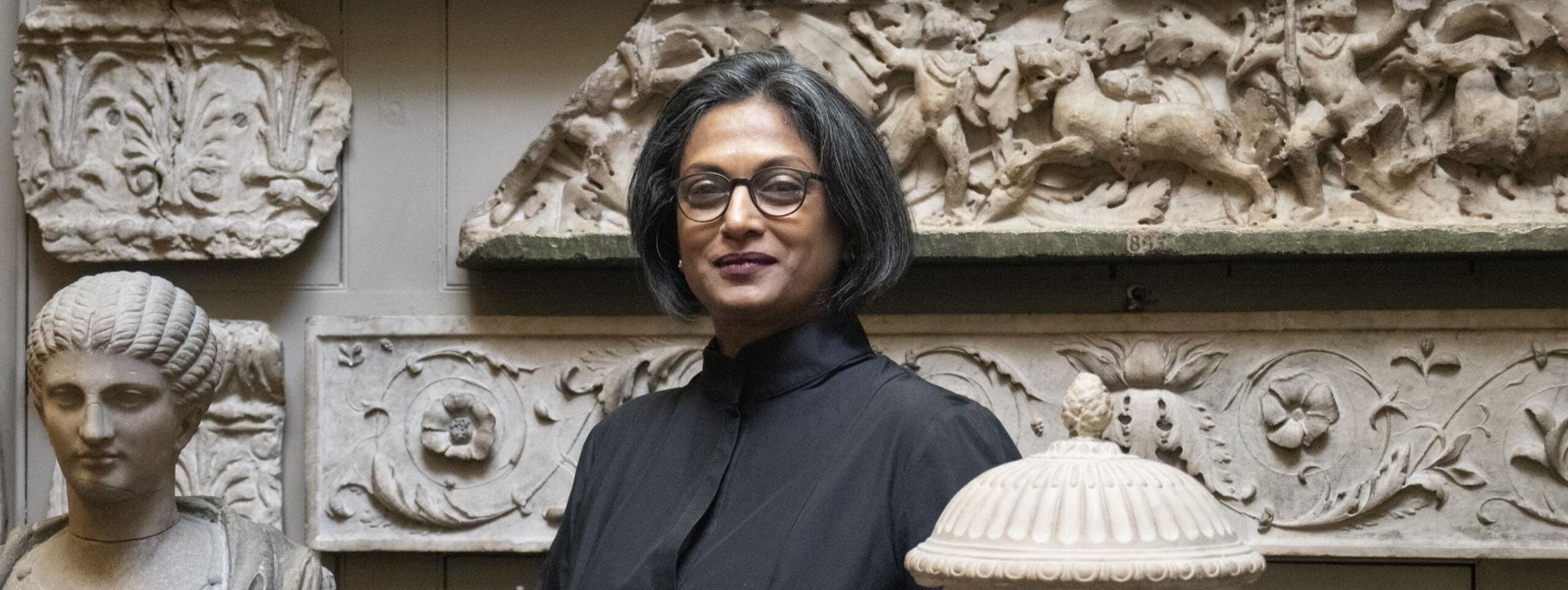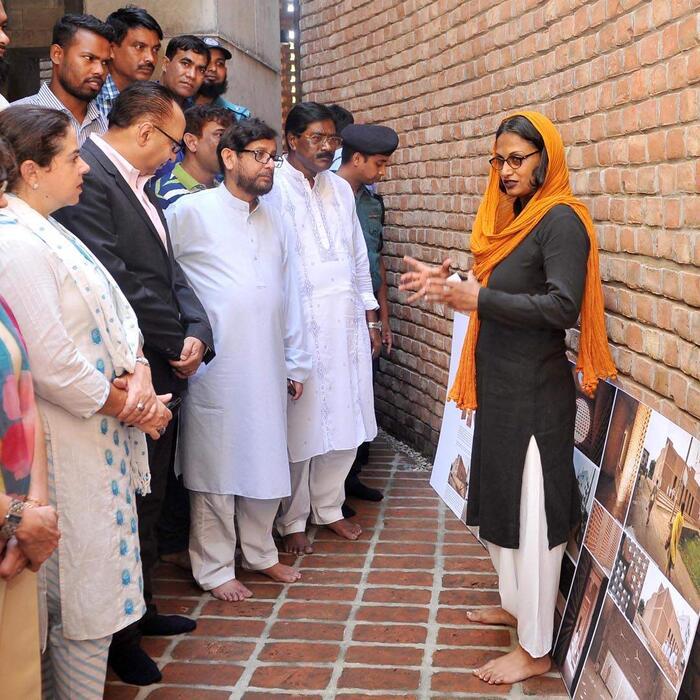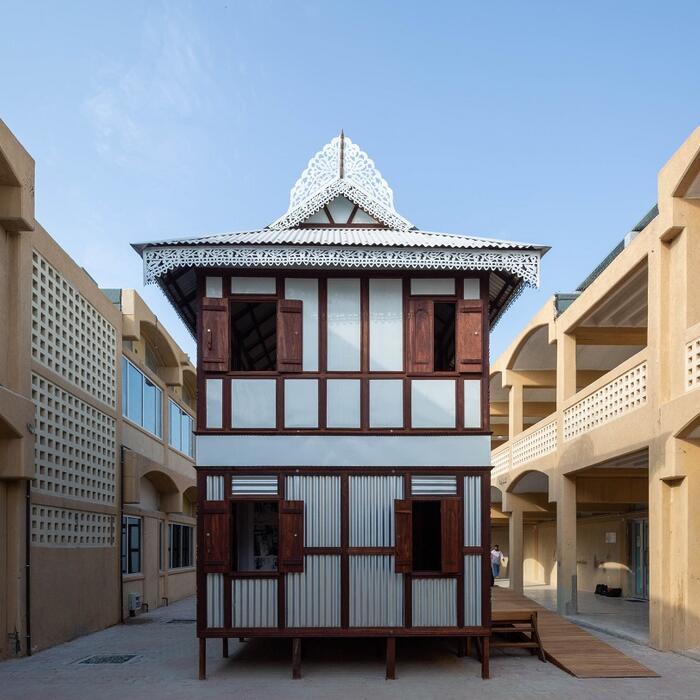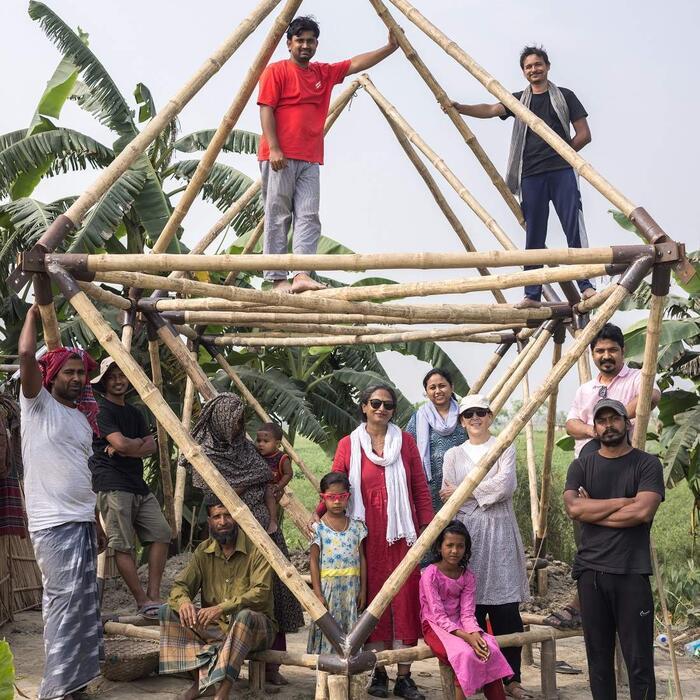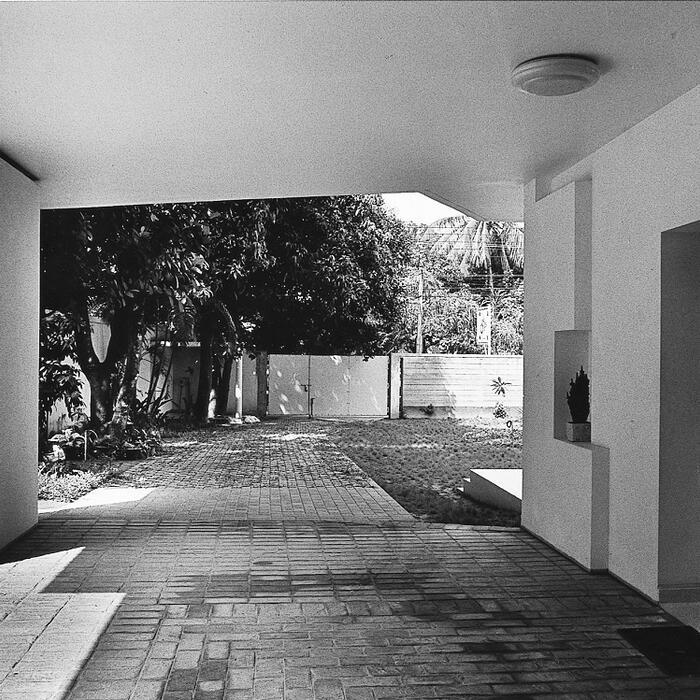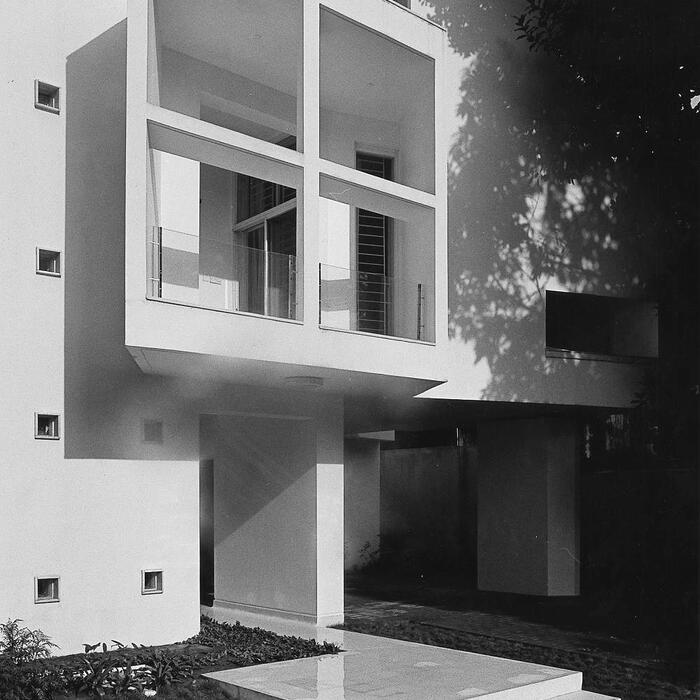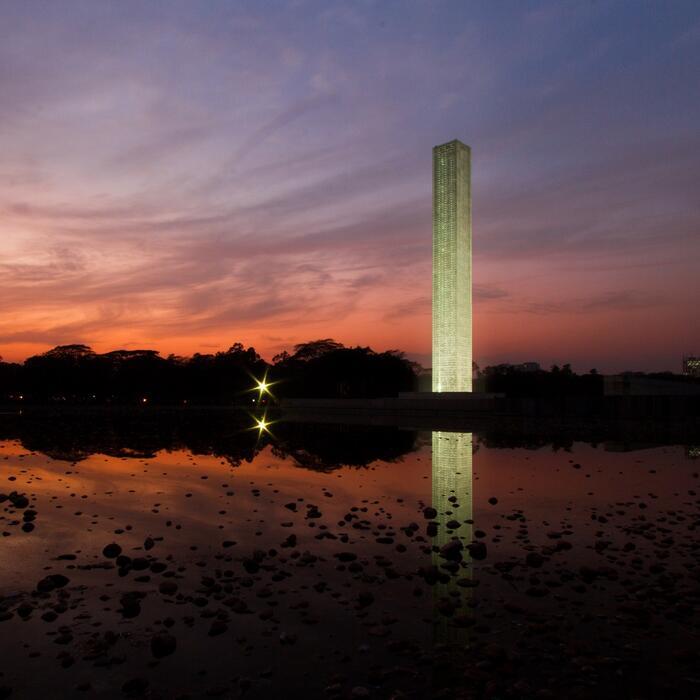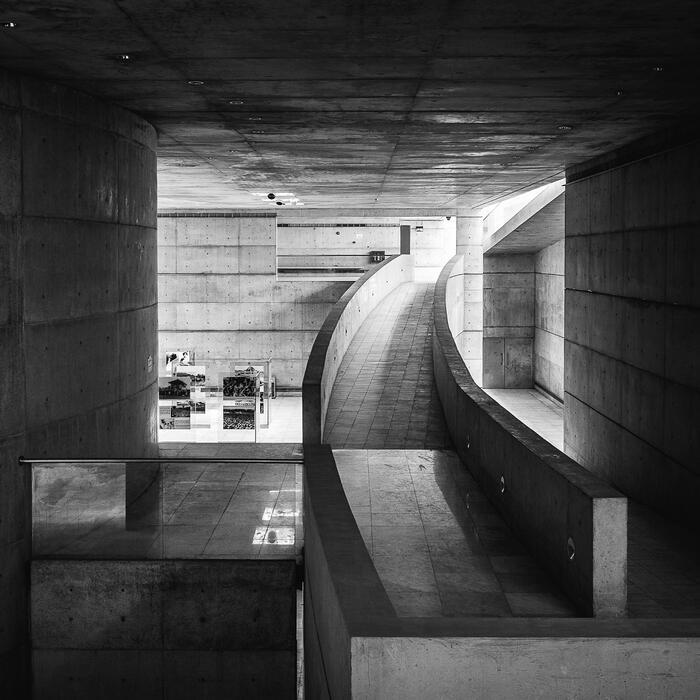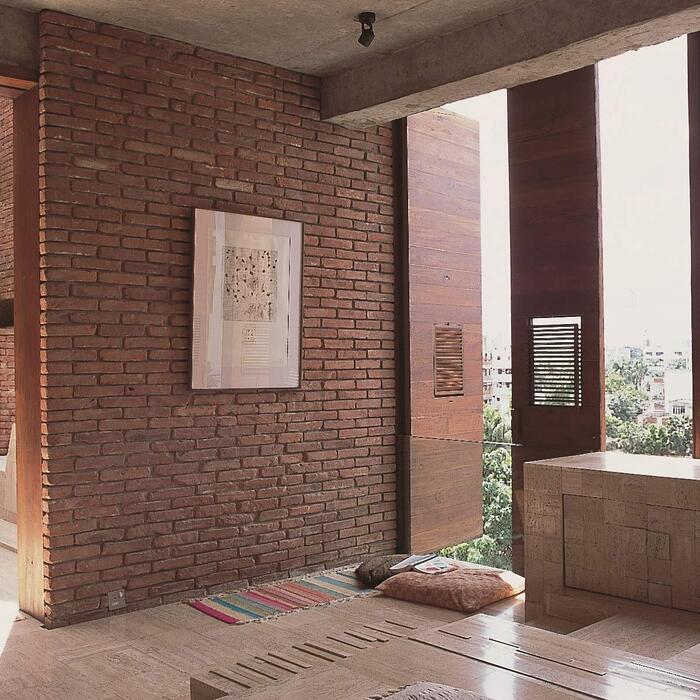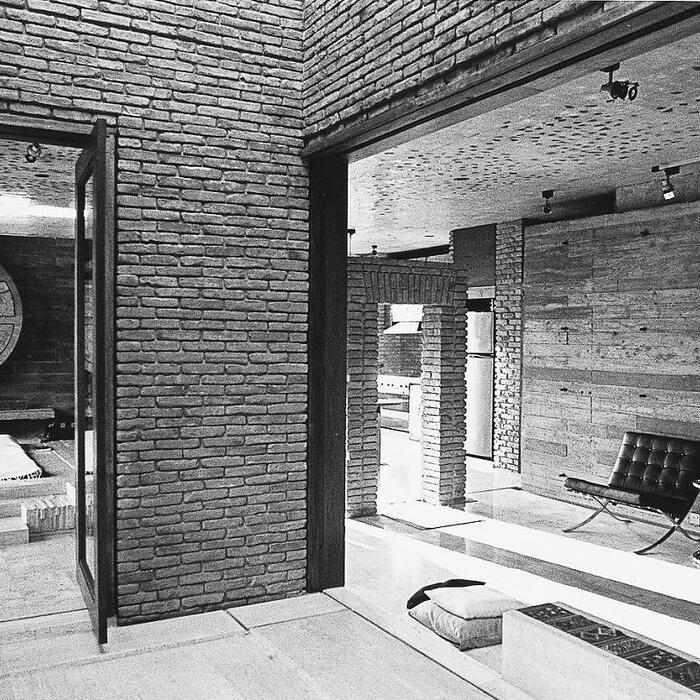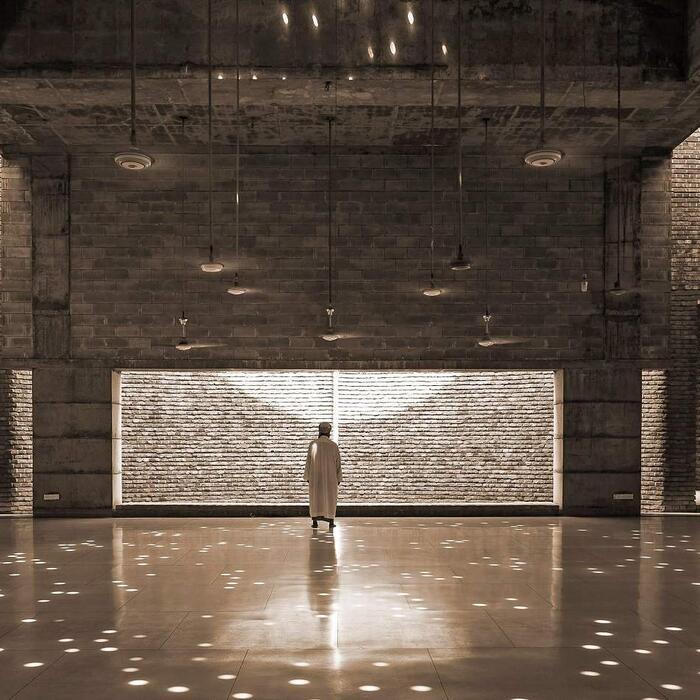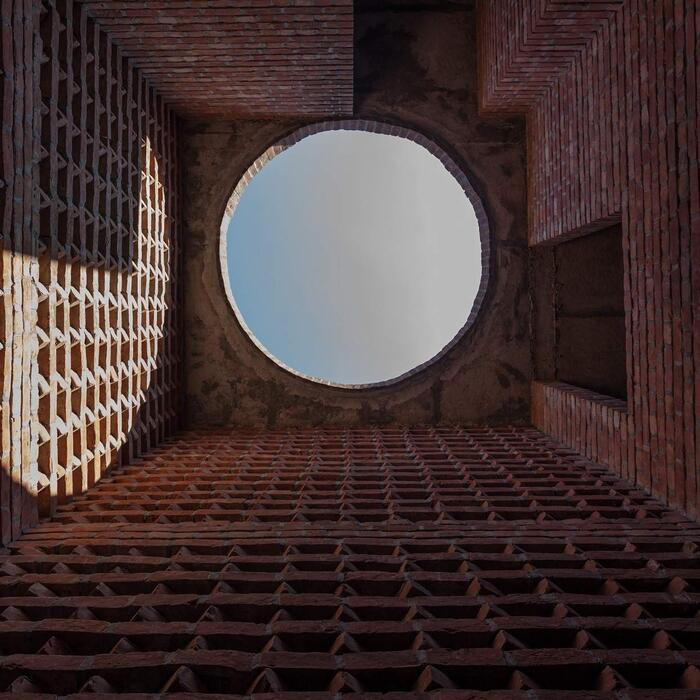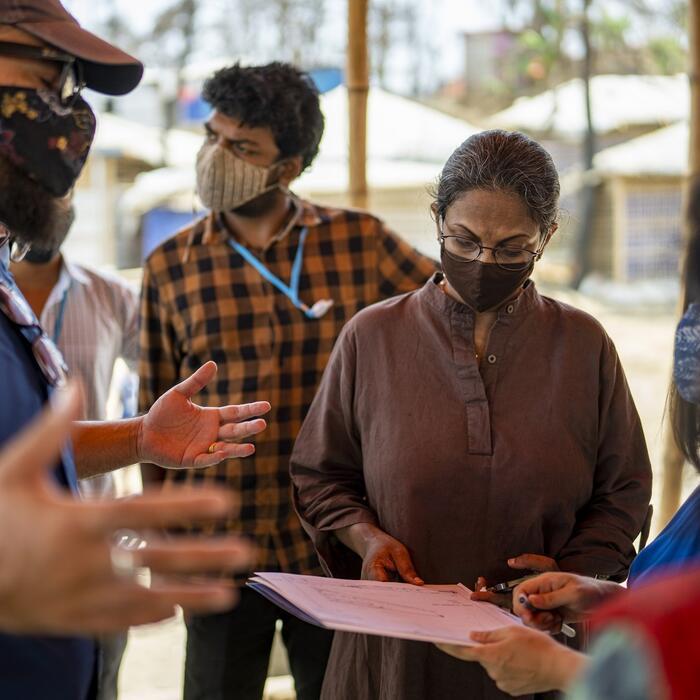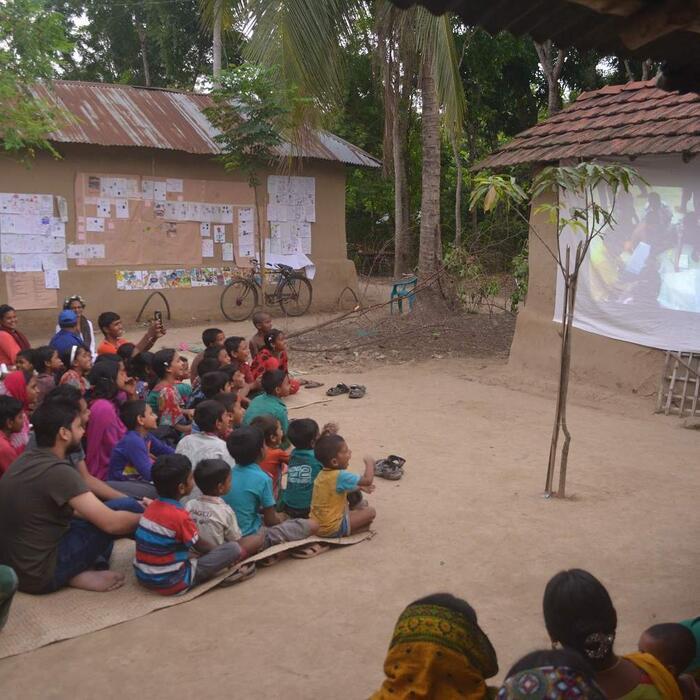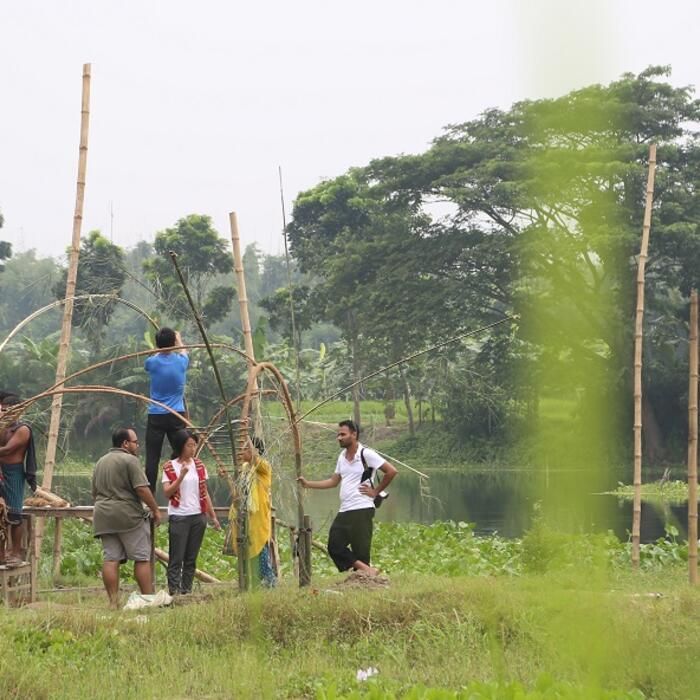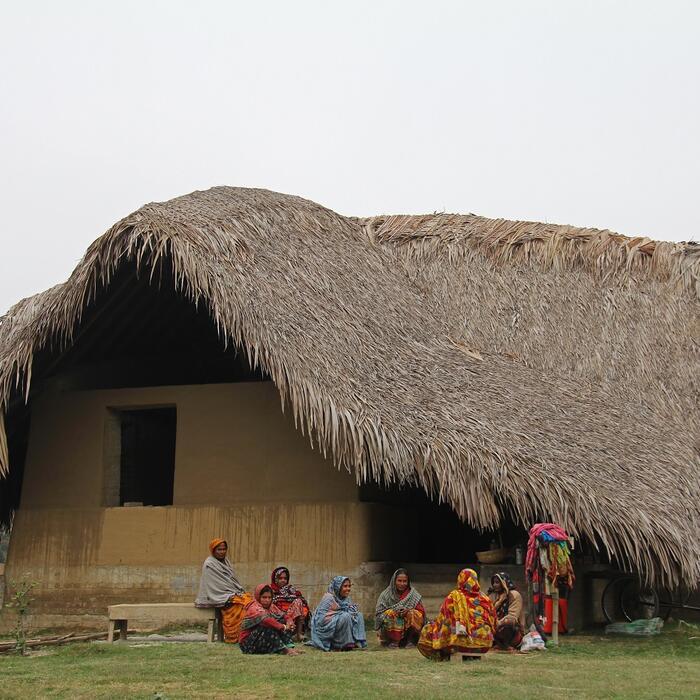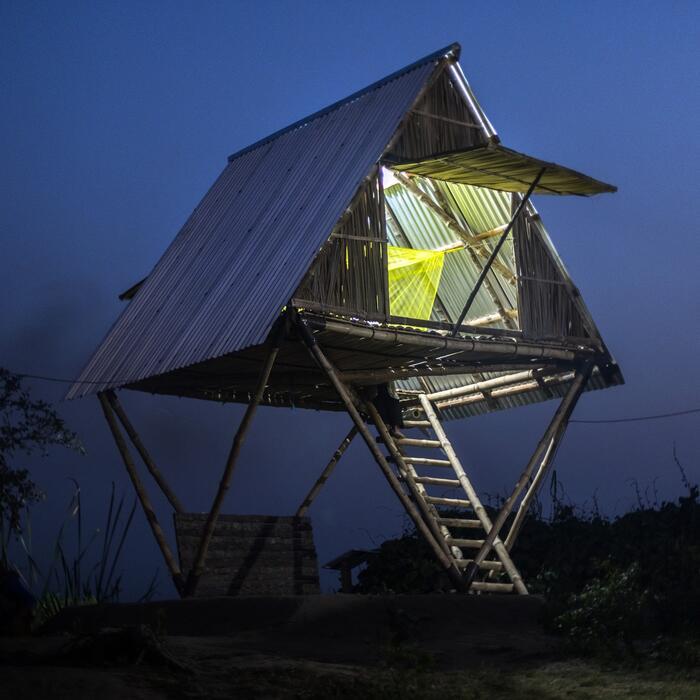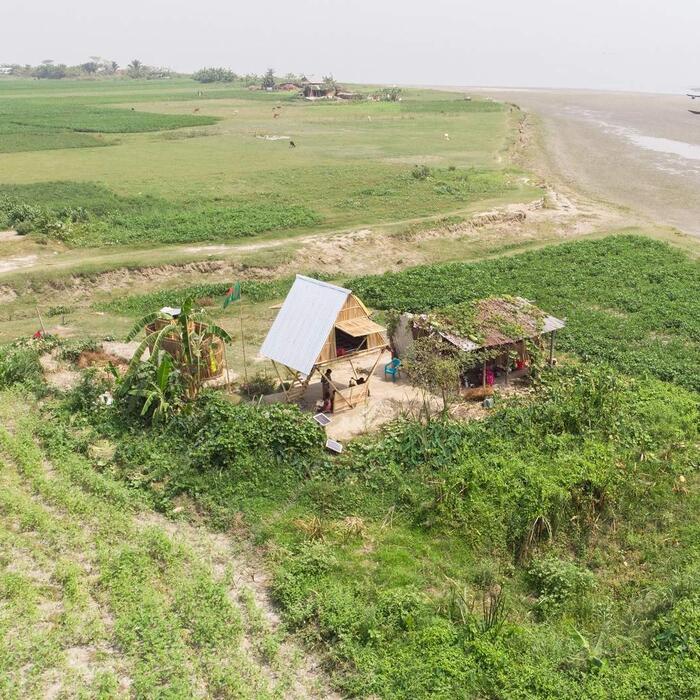Marina Tabassum, was born, lives and works in Dhaka, Bangladesh. She is Founder and Principal Architect of Marina Tabassum Architects MTA in Dhaka and is a pioneer of what she describes as ‘the architecture of relevance’.
Her practice focuses on designing buildings in tune with their natural environments (in particular, working with local materials and communities) while also embracing the design challenges of sustainability, environment, and our collective impact on the planet. She is currently working in the Rohingya refugee camps in Cox’s Bazar, in south-east Bangladesh, and designing mobile modular houses for ultra-low-income people in the country’s coastal areas.
Her notable buildings include the minimal, sun-dappled Bait Ur Rouf Mosque, opened in 2012, the Independence Monument of Bangladesh and the Museum of Independence. She was winner of the Aga Khan Award for Architecture in 2016. In 2018, she took part in Freespace, the main exhibition of the Venice Biennale for Architecture, where she explored the Bengali courtyard.
She is Visiting Professor at the BRAC University in Dhaka. She runs undergraduate studios at the University of Asia Pacific, and has given lectures and presentations at a number of other educational institutions and conferences having been the Director of Academic Program at Bengal Institute for Architecture, Landscapes and Settlements since 2015.
The following text covers much of Marina's Soane Medal lecture, delivered on the 16 November 2021.
Watch the lecture Back to top
Home Back to top
I am 52 years old. Unlike the giants who preceded me to this lectern, I consider myself a work in progress: the search is still on. The anxiousness of many years has evaporated with my turning fifty: choices made, roads taken; all leading me to a point of no return. This is not the time to reminisce on a past that could slow me down. This is the time to pour out all that was gathered over time, through relentless search, to contribute to the pursuit of architecture. The search never ends – it leads us to places, encounters, acquaintances and expanded horizons: sometimes to failures and realisations – but one must never arrive, arrival stops growth. There is still so much to learn, to realise, to develop.
I am in the middle of my journey. It is not time yet to look back and pick up the pieces to tell my tale. My stories and encounters are being collected and archived in my memory for the future. Someday, when I’m sitting on the porch of my farmhouse, which I’m yet to build, up in the north in Rohanpur, looking across the mango orchard and into the horizon, I will reminisce upon days gone by. I might then go back to the earliest memory of my life, to the sounds of destruction amidst Bangladesh’s liberation war in 1971. My story begins there, with my two-year-old self still holding on to the sadness of my grandfather’s passing in the middle of the war, watching from my grandparents’ house in Shantinagar as the police barrack in Rajar Bagh blazed with fire. The sirens and subsequent blackouts of air raids are still unsettling memories. I was introduced to death and destruction before I was enrolled in elementary school.
Growing up in the 70s – in a war-ravaged, fledgling nation of 70 million, full of uncertainties and minimal means – the children of my generation matured somewhat faster than usual. There were no toys to play with; and so we invented new games for ourselves. My childhood-self witnessed a country in a famine in 1974. Children of opulence will never know the power of imagination that can turn a rice ball into a boiled egg. I realised very early in life that limited means cannot limit dreams; these limits instead open the window of innovation. This lesson from my modest upbringing informs my work thus far.
Walls have two sides Back to top
The walls in my childhood had two sides. On one side was my grandparents’ property; a two-storey courtyard house secured with high walls: on the other side of the wall was the rickshaw pullers’ slum. The life of a child was dictated by which side of the wall he or she was born. On one side there was privilege, opportunity, aspiration; and on the other was struggle, and more struggle. We, children, played together in the field, unaware of the differences between us and how our beginnings would, in turn, impact our futures.
They didn’t go to school. We did. I was aware of the privilege we were born into. Unlike many, my family had the means to provide my siblings and me with a good education and opportunities for growth. I grew up in an environment where there was no discrimination between boy and girl. Even more fortunate, our parents instilled in us the importance and value of giving. My father being the only doctor in the neighbourhood, each morning we would wake up to a long line of patients from the neighbouring slum; he would attend to each one of them before setting off to work. In many ways, I seek to repeat that compassion through my architecture by expanding beyond the architectural programme, moving past the site boundary to attend to the human condition and the local ecology of sustenance. In this pursuit, I am trying to establish a sense of social and environmental responsibility that transcends architecture’s quintessential agenda of space and form.
Being a doctor, my father’s presence in our daily lives was periodic. Whereas my mother, a homemaker, invested all her time and energy in our upbringing, education being her priority. As the eldest of four children, I was her most important project. I must succeed in order for the rest to follow. During my school career – from primary years to graduating with an architecture degree – my mother was relentless and ever-present; providing everything that was humanly possible. She was successful in her pursuit that resulted in a doctor, an engineer and an architect before her passing in 2002.
A Bengali, or a Bangladeshi? Back to top
Both my grandparents were immigrants. Their new life in Dhaka began after the partition of the subcontinent in 1947.
They were residents of Malda, a district now part of West Bengal. My father was ten years old when his family left home in the middle of the Hindu-Muslim riots. A base of a huka, intricately inlaid with silver, is the only physical memory that connects him to his home in Malda. He never found closure. He longed to go back home, but even though the nightmare of partition would end, he could not return to what was lost. Home became a longing, a story he would tell his grandchildren.
‘Desh’ refers to one’s origin, the village home. Locating ‘Desh’ is a shared quest, embedded in the culture of Bengalis. Throughout my growing years, I struggled with the answer.
For my family, and also for my generation, ‘Desh’ is no longer a place, but a story. A story of forceful uprooting, a story of leaving everything behind that our ancestors knew as home. A story of settling down and adjusting in a new territory. We, the third generation of an immigrant family, grew up with stories and mental constructs of a lost home that exists only in our imaginations.
Being born and brought up in the capital city of Dhaka, my connection to the villages were few and far between. The eternal beauty of the delta land revealed herself to me only in the last decade in various projects in the Ganges Delta. I found my ‘Desh’ there, through the interactions and connections I felt with rural Bengal, the soul of the delta land. There is inherent wisdom embedded in living symbiotically with nature. There, families do not aspire for their own dwellings to be different from their neighbours’; values are rooted in homogeneity and a communal way of life.
Architecture, a calling or an accident? Back to top
In a family of technocrats, it is taken for granted that one would either choose to be a doctor or an engineer. But I had a mind that sought freedom and could not be tamed by convention. My parents knew me well: my father suggested, ‘Why not architecture?’. In the late 80s, there was only one school – Bangladesh University of Engineering and Technology – that offered architecture courses to 50 students in a country of 12 million. The admission was tough and one had to sit for an entrance exam.
In light of this statistical unlikelihood, an architecture student was appointed to impart the basic knowledge of composition and design that I might go on to study. I felt an immediate connection to architecture, a sense of discovery and freedom that turned into a strong determination; a journey that began for me in 1989. Even in the 80s, the profession of architecture was fairly new in Bangladesh and was still struggling to establish a place beside an engineer-dominated construction industry. The architecture school was set up in 1962 with a grant from the Ford Foundation. Richard Vrooman (a professor from Texas A&M University) was the first dean. The curriculum that was set up in the 60s continued in the late 80s; a heavy dose of modernism at a time when the postmodern movement had taken root in the West. We, students, learnt to dislike ornament and adore form-finished concrete. In a pre-internet era, our only window to the world beyond Bangladesh was through books in the university library; we dutifully spent long hours admiring the works of the modern architectural masters of the twentieth century. I particularly enjoyed a book on Luis Barragán that instilled in me a longing to visit Mexico. But the book I repeatedly returned to for inspiration was a volume on the New York Five; these maverick architects and their buildings were as exciting to me as Coca Cola.
My biggest takeaway from school now, is the backpacking trips I took with friends through the subcontinent, from Ajanta to Elora to Fatehpur Sikri, my peers and I exploring the richness of our own history. Those of us who grew up outside of the West – yet with every aspect of our upbringing influenced by Western thinking – grew up quite confused. Self-esteem was low growing up in a country ravaged by war and poverty, and challenged climatically and politically. Few talked about patriotism while growing up in the eighties. Some of us learnt to reject our own context and aspired for a life in the West; many of my friends responded to that calling and left for good. There were also a few amongst us who aspired to retain cultural integrity by embracing localness. I am a firm believer in mediation and sought balance through negotiation. I sought to root myself as much as I aspired to explore.
Light Back to top
The parliament complex by Louis Kahn is a much-revered building in Bangladesh and it was ritualistic for architecture students to visit the complex with our professors. The ambulatory is the urban street that connects eight building blocks to the central chamber: the street is a room lit by sunlight filtering through glass bricks embedded in the roof. The brightness of the direct sun filtering through the ceiling bricks reveals the dramatic play of light and shadow. As the clouds cover the sun, the light inside the ambulatory softens, giving way to a sombre mood. How the atmosphere inside a building, in this building, could change with the movement of the sun and clouds was my first lesson in daylight.
Kahn occupies a place next to the gods in Dhaka’s architectural realm. Like the rest, I learnt to worship him. First blindly, without fully comprehending why; later through appreciation and reverence. The magic and harnessed power of light that I first experienced in the ambulatory of the parliament building became a relentless search for the spirit of architecture, a spirit that is an extension of us. A building is an entity that enters into silent dialogue with the dweller. Together they create memories, share stories, shaping and aging together. At times a building can teach us more about architecture than schools can; the parliament building of Bangladesh is one such building
The spirit of place Back to top
Architecture has given me more than I had anticipated. A few choices made very early in my journey defined my practice over the years. When I graduated from architecture school in 1995, the affliction of consumer architecture had already infested the city of Dhaka. Architecture practices based in Bangladesh, as elsewhere in the world, were busy designing multi-tiered, residential and commercial blocks ready for sale. A generation of fast-bred buildings, primarily focused on profitability, sprung up in the blink of an eye and the sad cry of destruction from the older fabric of the city was overpowered by the cacophony of the arrival of the new.
The first confrontation of my professional life was coupled with the commodification of architecture, as I witnessed the global tendency toward instant gratification and industrially produced anthropogenic materials devised to standardise the entire globe. The quest for my own identity – my ‘Desh’, that which I had sought since my childhood – seemed diluted within high-flying capitalist culture. The icon-mania of the super-rich and stardom of architects brought about a crisis. It is a point of crisis when an architect must decide whether to indulge in easy excitement or to choose a path of resistance.
I chose to resist, to deny temptation and to search within; within the land I grew up in, the place and country I call home.
The fragile delta – where no one knows where water ends and land begins – exhibits a magical chemistry embedded in the psyche of its local people, their life and living. The abundance of rain is a blessing in monsoon season, while the dry days of winter are quiet breaks. The earth is generous, vegetation lush and the history rich. The spirit of the Delta offers insight into a unique material palette defined by climate, location, culture and history; and yet the spirit of time draws attention to the evolutionary nature of a socio-economic-cultural atmosphere that is in constant flux. Muzharul Islam, the first Bengali architect of Bangladesh, my mentor and guide, stressed on rootedness in order to produce a work of architecture that is an offering to this matrix of people, place, time and context.
URBANA, 1995 - 2005 Back to top
URBANA, my first partnership and practice, was formed with Kashef Chowdhury in November, 1995. Our passion for architecture resulted in a deep friendship and belief in the craft, resulting in a decade-long partnership in both work and life. At that time, a leading Real Estate company in search of ‘wow-factor’ designs approached us to commission thirty of their high-end development projects. Looking back, I can only be proud of rejecting the temptation of the offer. Though the path after this was challenging, we sustained the passion of our practice through small yet meaningful commissions.
In 1997, one and a half years after our practice’s conception, we won a competition to design and build the Museum of Independence of Bangladesh in Dhaka. Hard won and much awaited, we nonetheless understood the immense responsibility associated with the opportunity. The project demanded an investigation into contemplation and timelessness. The liberation of Bangladesh is a tale of duality: independence gained through the selfless sacrifice of a brutal war. Freedom has a preferred direction: upwards. Anything aspirational assumes an upward gait. And yet, memory, loss and sadness urges for the subterranean: a desire to be buried and also, after a time, unearthed. We introduced a horizontal expanse parallel to the flatness of the park, a platform of celebration: and a vertical offering of hope, defined by the Tower of Light. The history of revolution, struggle and genocide was gently tucked below ground in the museum beneath the plaza. The project that began with positive vigour in 1998 finally found its completion, sixteen years later, in 2013.
Before this, our first completed project as URBANA was NEK 10, a family residence in Dhaka. A project with a modest budget, we explored the very basics of materials and responded to the tropical climate with large openings, terraces, verandahs and open green space. In the subtropical, humid climate of Bangladesh, architecture can essentially be a pavilion: a roof to provide shelter from the elements and a plinth to keep us above the monsoon rain are adequate to create a primal hut.
Another notable project, A5 Pavilion Apartment, was built as our own residence and cemented many of our explorations around climate appropriateness. Here we attempted to further blur the edges between inside and out. The large volume of the nature court combined with flexible shutters to create airflow, kept the spaces ventilated throughout the hot summer months. The project addressed the basic methodology of reduction, redefining 1,250 square feet of free-flowing space on the top floor of a contemporary urban apartment dwelling. The first step of planning was to strip the clients’ architectural requirements down to only the essential of human activities, in order to discard the complexities and extract the basic essence of living. This generated four major spaces: eating, sleeping, socialising and being with nature. This project sought out ways of repurposing discarded materials, hand-crafted to renew. A5, designed as an Architects’ Residence, was completed in 2001.
Ten years in URBANA helped to craft my confidence, so as to combat the inhibitions, intimidations and fears of being a woman in a man’s world. I spent long hours on site, at times staying up all night in the cold winter months and during trade shows to meet deadlines. It’s all in the attitude; knowing one’s craft and fostering connections with the people who give life to one’s drawings.
MTA, 2005 - Back to top
Unfortunately, the partnership which formed URBANA did not end in peace. I left the practice and gathered the self-assurance and vision to set out on my solo journey in the pursuit of architecture. Marina Tabassum Architects (MTA), a studio-based practice, was set up in June, 2005. I decided that my passion would be the driving force behind the endeavour, with a focus on combining research, teaching and practice to inform our output. I decided consciously to keep the office and staff size at optimum operational levels, in order to select projects carefully and limit their number each year.
A building must breathe without the help of artificial means. That is an obsession, I confess, that I pursue quite earnestly in all projects. Porosity of the building skin, open courts and long verandahs are ingenious traditions from the pre-air-conditioning-era that are still valid in contemporary times. Investigations into contemporising these techniques in order to reduce dependency on mechanical means resulted in several MTA projects that employ spatial planning and the addition of voids and stacks to allow cross ventilation.
Spirituality vs symbolism Back to top
In 2005, around the time MTA was founded, one evening my grandmother, Sufia Khatun, invited me for tea. She had with her a map of the land she owned in the north of Dhaka. She offered to donate some part of it to build a mosque. It was her wish that I design and build her dream project. Since my grandfather’s passing in 1971, she had lived a very modest life as a widow in a white saree: the sudden demise of my mother, her eldest child, in 2002 put her in a deep sense of loss. So too for me; this loss was perhaps the lowest and darkest point in my life to date. It was a moment in time when grandmother and granddaughter both sought healing and designing the mosque became our process. My grandmother passed away within a few months of the ground breaking at Bait ur Rouf Mosque in December 2006.
The promise to realise her dream turned into a six-year project where I was the architect, builder, fundraiser and client. Bait ur Rouf Mosque was the first commission of MTA and also the most revered around the world.
The initial idea was to search for the essence of Islam, devoid of ritualistic and symbolic attributes – to question, ‘What is a mosque?’. The first mosque of Islam was built under the directive of Prophet Mohammad. It was primarily a space for a congregation of followers. In addition to communal prayers, the mosque housed social, administrative and judicial events that helped establish and spread the doctrine of the religion. The genesis of the mosque form has its roots in the vernacular house tradition of Medina, elongated to hold the assembly of Friday prayers. Clarity of space, devoid of hierarchy, is tantamount. Instead of glorifying symbolic features such as domes or a minaret, it felt right to focus on the spirituality of the space that would heighten one’s sense of being in communion with God.
Light became the major element of design.
In Bengal, the glorious legacy of mosque architecture dates back to the thirteenth century with the advent of Islam confirming the age of the Sultanates. Built in brick, these mosques adapted to local building traditions. I took inspiration from these brick structures in order to re-establish the lost connection between the contemporary practice and the rich heritage of mosque architecture.
Dhaka is one of the densest and the fastest growing cities in the world, with some 20 million inhabitants. Due to the lack of decentralised planning policies, all roads in the country lead to Dhaka. The northern fringe of the city used to be farmland, which went through rapid transformation to become residential settlements over the last two decades. In anticipation of a dense, unregulated neighbourhood, the mosque offers order in chaos. The main prayer hall is designed as a place of refuge where everyone is welcomed; a pavilion on eight columns wrapped in a brick structure that houses the ancillary functions of the mosque. The punctuated brick walls and open courts help to keep the building ventilated throughout the summer months and create a truly porous building, open to external light, sound and climate.
The local community, who are the main mosque attendees, helped with the process of construction by funding the building in small amounts; this fostered a sense of communal ownership. The space, form and material remain in their elemental state – light being the only ornament that glorifies the atmosphere – and they respond to the six seasons of Bangladesh.
Process vs object Back to top
The building industry in Bangladesh relies upon unskilled physical labour. Very few people can read construction drawings. Quite often, architectural instructions and designs are communicated with sketches, samples or 3D renderings, alongside vigilance onsite to avoid major errors in construction. This has allowed me and my colleagues to develop some long-standing relationships with highly skilled artisans; thus we learnt to appreciate the beauty of imperfections of hand crafting.
90% of Bangladeshis have little to no familiarity with architects or architecture as a profession. Quite often, participatory processes are required in order to be inclusive and to develop a sense of ownership in projects for the community.
Our projects in the Rohingya Refugee Camps in Ukhiya focus on building resilience of people and nature through co-creation. The natural forest in Teknaf was ruptured by the influx of one million refugees from Myanmar in 2017; this high density population and lack of vegetation subsequently resulted in rising temperatures in summer and landslides during the monsoon season. Our project includes participatory workshops and engagement within these refugee communities to facilitate regeneration of the forest through various methods of planting, including seed bomb and bamboo nailing techniques. The activities are not only therapeutic but also enable participants with the knowledge of and motivation to care for the environment.
In Louis Kahn’s words, ‘…architecture has no presence .… Only a work of architecture has presence, and a work of architecture is presented as an offering to architecture. Architecture has no favourites;…it has no preference for technology. It just sits there waiting for a work to indicate again to revive the spirit of architecture by its nature, from which people can live for many years.’
It is immensely liberating to realise that an architect is not bound by the four walls of a building but instead can engage in broadening the agenda of architecture. One can transcend visual dominance and object-making towards an architecture of relevance, in response to time’s needs.
Dwelling in the delta Back to top
The Panigram Resort in Jessore is 150km to the north of the Sundarbans (the largest mangrove forest in the world and home to the Royal Bengal Tigers) and to the south of the Padma river. The southern part of the Padma river was created by pro-gradation of the Ganges estuary by accumulation of silt. This highly fertile land of the matured delta is predominantly agrarian.
My first visit to the site in 2013 revealed the innate beauty of living symbiotically with nature. The thought of invading this primal quietness of life with the roaring noise of architecture felt like a crime. Ironically, the villagers, especially the younger generation, are drawn to the glitz of city life. For them, the city holds all the answers to their troubled aspirations for a ‘better life’. As news of our project travelled through the village, the community expected (and were excited by) the new ‘Dhaka’ that was to be born in the remote village of Taherpur. Instead, we visited houses and enquired about the recipe for building with mud. We praised the women who maintained their mud houses so beautifully, as if they were pieces of art. The village elders – those whose knowledge had become obsolete – were suddenly once again a rich encyclopaedia of information, a reference for our conversations.
A courtyard ‘uthan’ – the lived space – is the soul of a Bengali household. Undefined by any physical boundary, an ensemble of the elements of daily life are casually placed to give a sense of enclosure. Earth as its floor and sky as ceiling, the room repeats from one court to another, creating a social atmosphere – every household is unique, yet with a deep sense of communal connectivity. It is a theatrical display of life lived with nature. From dawn to dusk, the space changes character as the users move through their daily rituals of livelihood. MTA’s installation at the 2018 Venice Biennale, ‘Wisdom of the Land’, presented a courtyard of a Bengali hut as a response to the curators’ theme of ‘Freespace’. The structures we presented in the Arsenale built upon these traditional techniques of space-making, as well as our research within them, producing an ever-changing, adaptable architecture that went beyond the visual choreographing of daily life.
The Panigram project offered an opportunity to bring back the lost pride and belief in the wisdom of the land crafted over hundreds of years of dwelling in the delta. We believe that contemporary creative theory and practice must actively engage in reconnecting with the values of living meaningfully and symbiotically as a natural being. We opted for a minimally intrusive approach by including the villagers in the construction process and incorporating local knowledge of vernacular tradition. Through our engagement, we realised that keeping the Panigram villagers in their original locations would require provision of empowering opportunities, to revive the pride of craft, place and belonging. A cooperative named Panigram Community Initiatives was established to generate various activities and workshops to empower villagers to develop skills that would eventually lead to economic prosperity.
Another of the Panigram Resort’s community initiatives is the $2,000 Homes project, a co-creation model and education programme, initiated by MTA in collaboration with the community architects group, POCAA, to enable villagers near to the Panigram Resort to build their own houses. The process began by encouraging villagers to save, contributing small amounts to a seed fund (the collective savings of the villagers and one-time donation by Panigram Community Initiatives).
Members of the savings group can apply, each in turn, for a loan of up to $2,000 in order to finance the building materials for a modular house to improve their own living conditions. This is a budget for a building with two bedrooms and one bathroom. As architects, we listened to peoples’ aspirations: they design their dream houses as they have done for generations; and we provide our technical knowledge of and insight into space making. The process involves mutual respect and sharing. It is minimally intrusive to maximise the impact of architecture. This and Panigram Resort’s commitment to socially and environmentally responsible co-existence, in the context of Bangladesh’s Delta, sparked several subsequent programmes, bringing craft, food, agriculture, health-hygiene and education into focus.
Impermanence Back to top
The brick building tradition has strong roots in the Ganges delta. Architecture of power – be it political, cultural or religious – used brick when it sought permanence. The Buddhist monasteries dating from the third century BC were built with baked bricks; the Hindu temples showcase the finest terracotta depictions of the mythologies of Ramayana and Mahabharata.
In contrast, the architecture of human dwellings, those which frequently adapt to change and evolve, employ organic, impermanent and locally sourced materials.
Impermanence is embedded into the dynamic nature of the Ganges delta. The interplay of erosion and emergence is a unique phenomenon that has shaped the lives of Bengalis dwelling in this fragile land at the confluence of three major rivers, the Padma, Meghna and Jamuna. There exists a duality of joy and untold torment each year for a large number of people living along the banks of the streams of Bangladesh. The water level rises during the monsoon season (from June to October). The tributary streams carry excess water from the Himalayas, which causes the rivers to inflate and expand their territory, causing the banks to erode and readjust.
Along the Ganges-Bramhaputra basin, houses are adapted to a flat-pack system with a wooden frame and corrugated metal sheets. In the wake of river bank erosion, the locals disassemble their houses and move to safer locations. Houses move, the villages move along with the bazaars. In some cases, entire towns have shifted location. Some families have moved three or four times, while some have lost their means to start anew and moved to the city slums in search of their livelihoods. We attempted to showcase some of these stories – of complex existence and unending negotiation between human and nature – as part of our presentation at the Sharjah Architecture Triennial in 2019. In ‘Inheriting Wetness’, MTA’s investigation into landownership and precarious inheritance laws offered a closer look into the human lives affected by transient geoformations, accelerated by the effects of sea level rise. We bought three flatpack houses from a local market in Dohar and shipped them to the venue. On average, each house cost £1,500 and took three architects and a carpenter to put together in some fifteen days on site.
The Ganges and Brahmaputra rivers both combine to form one of the three largest river sources of water and sediment for the oceans. The tidal dynamics of low currents in the dry season forms sedimentation, locally known as char. For the landless (those with drastically low incomes), chars offer some years of relief as they settle with their families, fishing and cultivating the land. A shack made from tall grass costs nothing but provides a roof over one’s head. Chars are not land. They belong to the river. The transitory nature of these tread-able parts of the river does not allow long term planning. One must be ready with an exit plan in case the river overruns the char.
‘A place does not merely exist…it has to be invented in one’s imagination.’
The Bay of Bengal is a hotspot of climate insecurity, its ecosystem already affected with accelerated sea level rise. The irony is that the people in the coastal areas who are being affected by climate change have zero carbon footprint. These coastal communities rationalise the harsh reality as God’s will and keep adapting to the changing circumstances. We architects, as a profession, have a responsibility toward them. Part of that responsibility is about bringing change to a building and construction industry that contributes to 50% of climate change.
Architectural pedagogy needs to bring climate crisis to the forefront of education.
In 2020, our MTA office work slowed down during the first wave of the Covid-19 pandemic. We dedicated the lull to exploring the idea of a flat-pack modular house for the landless char dwellers. This exploration resulted in Khudi Bari, a lightweight modular spaceframe structure with bamboo and steel joints, easy to assemble and disassemble. A three-metre module of Khudi Bari costs £300 and can house a family of four. To date, we have housed four families in Char Hijla, in order to understand the natural responses of local people. We are in the process of housing one hundred families by June 2023. Architects of the twenty-first century must address the imbalance in our environment created by extraction, over production and exploitation of resources that has put our existence in crisis. Architecture can transform our stock pile of waste into potential building materials with collaborative research.
Architecture can reinstall pride in the age old wisdom of living symbiotically with nature. Architecture can empower communities to secure better lives and living conditions. And I firmly believe all this can be achieved without sacrificing the innate objective of space and place-making. Every site has a story.
Architecture adds to the narrative by building upon the ingredients sought out from these stories. Therefore, before we ask the brick what it wants to be, the conversation must begin with the question: ‘Who are you, brick? What is your story?’
